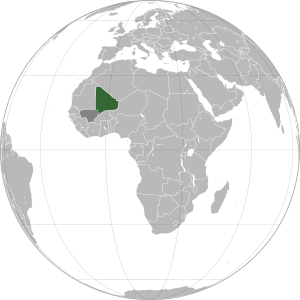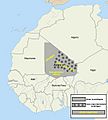Azawad facts for kids
Azawad is the name for the northern part of Mali, a country in Africa. The word "Azawad" means "savannah" or "pastureland." This area is mostly a desert region. For a short time, between 2012 and 2013, Azawad declared itself separate from Mali.
The territory of Azawad is divided into three main regions: Timbuktu, Gao, and Kidal. It covers a very large area, about 882,000 square kilometres (341,000 sq mi). The largest cities in Azawad are Gao, with around 87,000 people, and Timbuktu, which has about 55,000 people.
Contents
Understanding Azawad's Geography
Where is Azawad Located?
Azawad is found in the northern part of Mali, a country in West Africa. It's a vast area, mostly covered by the Sahara Desert. This means it has a very dry climate with little rainfall.
Key Regions and Cities
The territory is made up of three important regions:
- Timbuktu: This city is famous for its long history and ancient learning centers. It was once a major trading hub.
- Gao: Another important city, Gao is known for its role in past empires and its location along the Niger River.
- Kidal: This region is in the far north and is home to many Tuareg communities.
These regions are very spread out, and travel between them can be challenging due to the desert landscape.
A Brief History of Azawad
Why Azawad Declared Independence
For many years, some groups in northern Mali, especially the Tuareg people, felt that the government in southern Mali did not pay enough attention to their needs. They believed their region was not getting fair resources or representation. This led to several rebellions over time.
The 2012-2013 Conflict
In 2012, a group called the MNLA (National Movement for the Liberation of Azawad) launched a major rebellion. They took control of many cities in the north, including Timbuktu and Gao. On April 6, 2012, the MNLA declared Azawad an independent state.
However, this independence was not recognized by other countries or the United Nations. Soon after, other armed groups, some with different goals, also became active in the region. This led to more conflict and instability.
Return to Malian Control
By early 2013, international forces, including troops from France and other African countries, intervened to help the Malian government regain control. The MNLA eventually gave up its claim for independence and agreed to peace talks. Today, Azawad is once again part of Mali.
Who Lives in Azawad?
Diverse Ethnic Groups
The people living in Azawad come from different ethnic backgrounds. The largest groups include:
- Tuareg: These are a nomadic people, often called "blue men of the desert" because of their indigo-dyed clothes. They have a rich culture and history in the Sahara.
- Moors: Another group with a long history in the region, often involved in trade.
- Songhai: Many Songhai people live along the Niger River, where they practice farming and fishing.
- Fula and Bambara: These groups are also present, contributing to the diverse mix of cultures.
Life in the Desert Region
Life in Azawad can be tough due to the harsh desert environment. Many people rely on traditional ways of life, such as herding animals or trading. Cities like Timbuktu and Gao serve as important centers for trade and community life. Despite the challenges, the people of Azawad have a strong cultural heritage and a deep connection to their land.
Images for kids
-
Map of Azawad, as claimed by the MNLA. Dark grey dots indicate regions with a Tuareg majority. The west is mainly inhabited by Moors, and the south by sub-Saharan peoples.
-
A guelta (a natural water pool) in Adrar des Ifoghas
See also
 In Spanish: Azawad para niños
In Spanish: Azawad para niños










